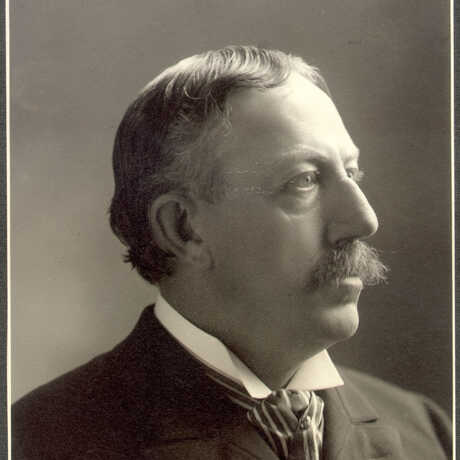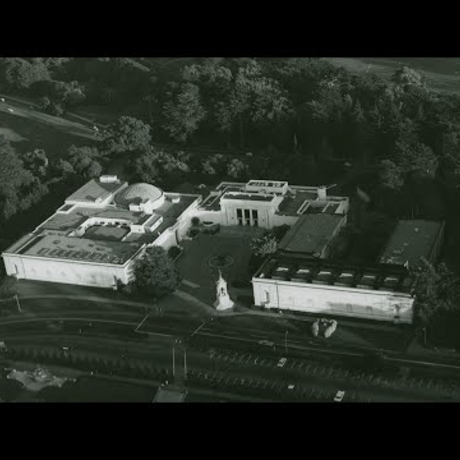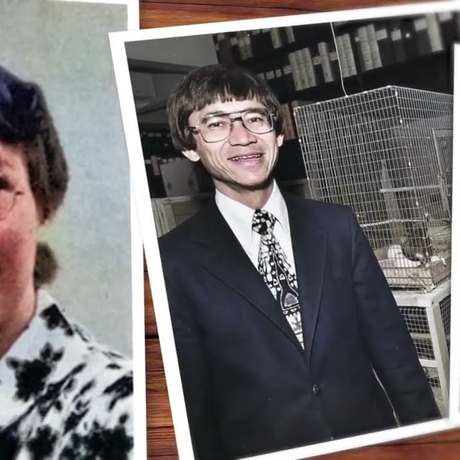Founded in 1853, the Academy Library is a research library devoted to natural history and the natural sciences. Explore our extensive collections, including rare books, serials, maps, and photography.
Untold Stories
Elizabeth McClintock

Introduction
Elizabeth McClintock was a prominent person at the California Academy of Sciences. She was a Curator in the Botany department at the Academy from 1949 to 1977 when she retired. She was not always appreciated, but her work greatly advanced the Botany department at the Academy. Despite the discrimination she faced due to gender and age she persevered in her field, helping to build the Academy’s botany collection and successfully working toward the conservation of plants in San Francisco. She also publicly protested the proposed Panhandle freeway, out of concern for the “ecological balance” in the surrounding area in the mid 1960s.
Early Life
McClintock was born on July 7, 1912 in San Jacinto, California. She was the oldest child of her parents. Her family moved to Arizona when she was a baby but moved back to San Jacinto when she was eight years old. McClintock showed an interest in botany from a young age; wondering about and caring for the plants that grew around her old childhood home. She had Indian Paintbrush, Owl’s clover, and lupines around her home but she didn’t learn much about plants until she attended Riverside Junior College.
Educational Background
At Riverside Junior College, McClintock was very interested in zoology, taking classes on the subject with Edmund C. Jaeger. She enjoyed having him as a teacher, but he never took the girls on any field trips. He’d take the boys in his class to the desert and teach them in the field but he never took girls. “That’s just the way things were,” claimed McClintock. Ruth Cooper, a former student at Riverside, taught McClintock’s first botany class in Junior College, “Identification of Spring Wildflowers.” McClintock continued studying botany in her higher education.
McClintock attended classes at the University of California at Los Angeles where she earned her Bachelor’s degree in 1937 and her Master’s degree in 1939, both in botany. Being from the small town of San Jacinto, it wasn’t common for many women to continue higher education after junior college. At the time, McClintock wanted to be a biologist or a high school botany teacher. McClintock originally wanted to study biology but it was not offered at UCLA. Instead, the school offered botany and zoology, so McClintock majored in botany and minored in zoology. This is where McClintock found an interest in taxonomy. As a student, McClintock had an average grade of a B in botany. McClintock was one of approximately three or four botany majors at UCLA. There were not a lot of students at that point due to the WWII war effort.
As an undergraduate, there were not many job opportunities for women, mainly just teacher roles. McClintock earned a high school teaching credential but never used it because she got a job at the UCLA herbarium during WWII from 1941 to 1947. She worked on taxonomic botanical problems. She created a monograph of the genus Monarda while working under some of the men in the botany department at UCLA as a graduate program for students with Master’s degrees. The war made it hard for McClintock to go to graduate school but when it ended McClintock earned her Ph.D. at the University of Michigan.
In the fall of 1947, McClintock went to the University of Michigan to earn her Ph.D. where she worked on taxonomy with Rogers McVaughn. She went to the University of Michigan because it offered assistantships. For her doctoral dissertation, she studied Hydrangea, a plant genus of over 75 flowers that are native to Asia and the Americas. McClintock was expected to finish graduate school by 1954 as she had a seven year time limit on her thesis, but she did not meet her deadline. She asked for a two-year extension and graduated in 1956. At the time she was also working at the California Academy of Sciences but she couldn’t afford graduate studies on the salary that the Academy paid her so she paid reduced fees for two school semesters. McClintock was the first Curator of Botany at the Academy to attain a Ph.D.
Years at the Academy
McClintock began her career at the Academy in 1948 as a Research Assistant in the Botany department before she was promoted to Curator of Botany in January 1949. McClintock went above and beyond in her role as Botany Curator at the Academy and was very often underappreciated for her work. She was the first in the Academy to create an organized and efficient botanical plant record system as well as consistently maintain the Academy's herbarium. She was crucial in the role of preserving the Academy’s collection of California native flora all while never being properly recognized by her supervisors. At the Academy, McClintock experienced a lot of discrimination in her role and was often told her line of work didn’t matter in the grand scheme of things. She was told by the director of the museum George Lindsay that ornamental plants (her specialty) were in fact not real plants and that anyone who studied them could not be considered botanists. She was looked down on as a woman in STEM and treated as a secretary despite her leadership position. She was underpaid because Lindsay did not think women needed salaries, and was often disrespected by her male colleagues.
She worked alongside botanist John Thomas Howell but felt very isolated at work. She was expected by Lindsay to show up to work and fulfill the role of an assistant or secretary. McClintock described her time in the Academy as routine and stated that her workday consisted only of answering phone calls, filing plant records, and tending to the herbarium. With a sexist director, McClintock’s department was always extremely understaffed and under-supported.
McClintock knew working in the Academy was harmful to her career, but finding another job at her age seemed impossible and she felt it was safer to stay. She remained in her position as a Botany Curator until 1977 when she was forced into retirement per the Academy’s policy. Employees at the time were expected to retire at 65 and McClintock was no exception. After years of discrimination and underappreciation, the Academy decided that there was no longer space for her position. One morning she was told to pack her things and leave by the end of the month without being given a clear explanation.
Like many women throughout history, McClintock remains gravely discredited for her impact on the Academy and science as a whole. Her intelligence and commitment to botany were extremely ahead of the Academy’s time and deserve the highest recognition.
Outside of the Academy
McClintock was very active in the botany community, serving as the editor and publisher for the Journal of the California Horticultural Society for 21 years. She was a member of the Arboretum Foundation since 1956. She was also a member of seven other organizations, including the Botany Society of America, International Society of Plant Morphologists, and the society of the Sigma XI which was an international scientific research honor society. More than 200 of their members were Nobel Prize winners. In addition to being a part of these organizations, McClintock also traveled to focus on botany and conducted research on the plants she saw. She traveled to London and did some research on Asiatic plants and reviewed several botanical gardens there. There was not any support for field work for the botanists at the Academy so McClintock was not often able to do much collecting, but she was able to collect plants in Arizona.
Values in Her Life
McClintock had a natural calling for protecting the environment. Her environmental advocacy was fueled by her love and passion for botanical life. In the early 1960s, McClintock publicly protested the development of the Golden Gate Panhandle freeway. In early July of 1964, the proposal for a freeway set to connect Golden Gate and Northwest San Francisco was approved. McClintock knew the freeway would have run through most of Golden Gate Park and was at risk of throwing off the park’s ecological balance. She stated “What I really hope to come out of the ecology movement is a greater impetus on the part of government agencies and developers and people who use the land before they make any final decisions about a development where a highway, where an airport will be located.”
In the 1970’s, McClintock also played a huge role in bringing awareness to the growth of dune tansies in Sutro Park. McClintock spoke out against the development of a $40 million apartment-shopping complex in Sutro Heights, an area that at the time was highly populated with rare dune tansies. Thanks to McClintock’s pushback, developers came to an agreement that the land in Sutro Heights needed to be protected, as well as other rare specimens and environments in California counties.
McClintock continued to promote environmental progression in her community by collecting, studying and preserving rare native plants such as manzanitas and sunflowers. McClintock did this for many years free of charge. Protecting the environment was her calling and she was inspired to expand her efforts by creating a conservation state agency. In trying to preserve an area in Fairfield, McClintock noticed smaller private conservation groups simply were not doing as much as one bigger agency could.
Life after the Academy
After McClintock retired she was not given an annuity because her salaries while working at the Academy were too low. Even though she was the Curator of Botany, McClintock claimed that she was paid “salaries that you paid the janitors.” After 30 years working at the Academy, McClintock was not given emeritus status; she continued her research with an honorary title from UC Berkeley. While at UC Berkeley, McClintock wrote treatments for families and genera for the Jepson Manual. She also co-authored Poisonous Plants of California with John C. Fuller (1986). Even after retirement, McClintock was still actively involved in the botanist community for 23 years, and worked on various botanical and horticultural projects such as ‘The Trees of Golden Gate Park and San Francisco,’ published in 2001. In 2000, at age 88, McClintock had to stop working due to illness and age. Four years later, Elizabeth McClintock died of pneumonia at age 92 while living at an Alzheimer’s care facility in Santa Rosa.
References
About. (n.d.). https://www.sigmaxi.org/about
Daniel, T. F. (2008, May 16). Proceedings of the California Academy of Sciences. https://www.calacademy.org/sites/default/files/assets/docs/pdf/history_botany_at_cas_pcas_v59apr08_daniel_pp_215-305lr.pdf
Edelson, D. (March-April 2022). Women Botanists of California. East Bay Regional Park. https://www.ebparks.org/ebrpd-celebrates/womens-history-month/women-botanists-of-california
Elizabeth McClintock Papers (MSS-315). Dept. of Library and Archives, California Academy of Sciences, San Francisco, Calif.
Estes, G. (2020, October 23). The Panhandle Freeway And The Revolt That Saved The Park. https://hoodline.com/2015/03/panhandle-freeway-revolt/
Holleuffer, C. (1985). California women in botany : oral history transcript / 1985 : Bancroft Library. Regional Oral History Office : Free Download, Borrow, and Streaming : Internet Archive. (2006, September 22). Internet Archive. https://archive.org/details/caliwomenbotany00hollrich/page/n187/mode/2up
Knight, H. (2012, January 19). Elizabeth McClintock -- botanist, author. SFGATE. https://www.sfgate.com/bayarea/article/Elizabeth-McClintock-botanist-author-2633410.php
Radcliffe, J. R. (2004). Elizabeth McClintock (1912-2004). Cal Academy. https://researcharchive.calacademy.org/research/library/special/bios/McClintock.pdf
About the Authors
Elena Gutierrez-Holley is a Careers in Science Level 3 intern at the California Academy of Sciences.
Jordan Hawkins-Collins is a Careers in Science Level 1 intern at the California Academy of Sciences.
Academy Library and Archives
California Academy of Sciences
55 Music Concourse Drive
San Francisco, CA 94118


